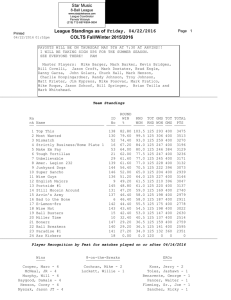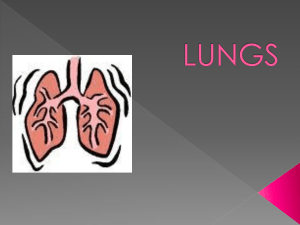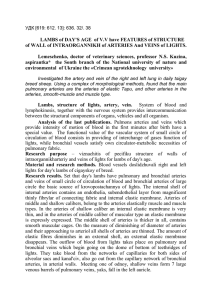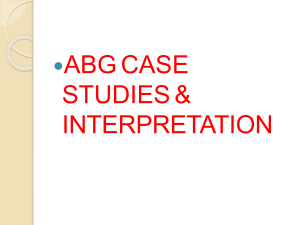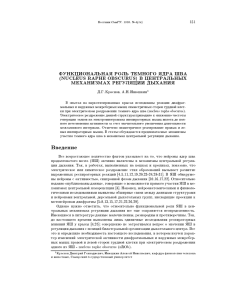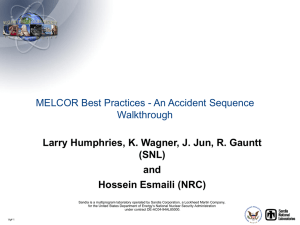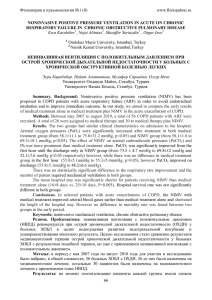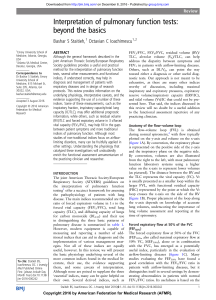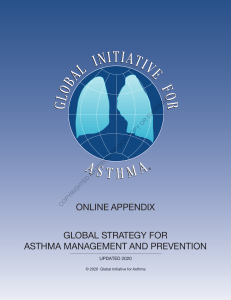Halotherapy for treatment of respiratory diseases
advertisement
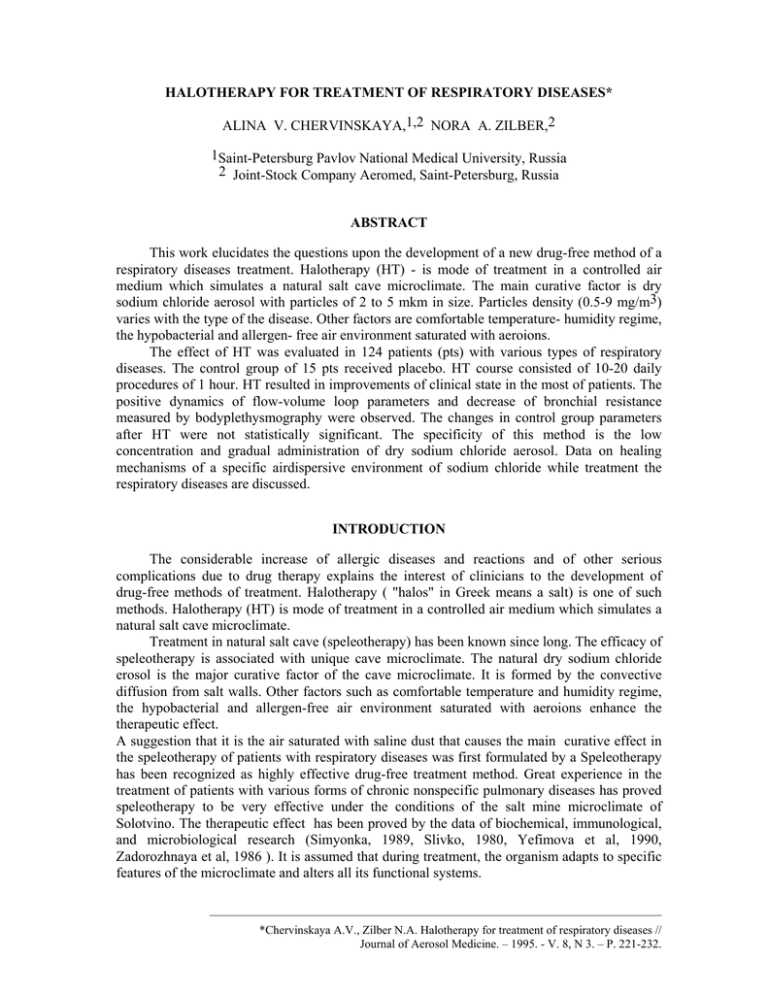
HALOTHERAPY FOR TREATMENT OF RESPIRATORY DISEASES* ALINA V. CHERVINSKAYA,1,2 NORA A. ZILBER,2 1Saint-Petersburg Pavlov National Medical University, Russia 2 Joint-Stock Company Aeromed, Saint-Petersburg, Russia ABSTRACT This work elucidates the questions upon the development of a new drug-free method of a respiratory diseases treatment. Halotherapy (HT) - is mode of treatment in a controlled air medium which simulates a natural salt cave microclimate. The main curative factor is dry sodium chloride aerosol with particles of 2 to 5 mkm in size. Particles density (0.5-9 mg/m3) varies with the type of the disease. Other factors are comfortable temperature- humidity regime, the hypobacterial and allergen- free air environment saturated with aeroions. The effect of HT was evaluated in 124 patients (pts) with various types of respiratory diseases. The control group of 15 pts received placebo. HT course consisted of 10-20 daily procedures of 1 hour. HT resulted in improvements of clinical state in the most of patients. The positive dynamics of flow-volume loop parameters and decrease of bronchial resistance measured by bodyplethysmography were observed. The changes in control group parameters after HT were not statistically significant. The specificity of this method is the low concentration and gradual administration of dry sodium chloride aerosol. Data on healing mechanisms of a specific airdispersive environment of sodium chloride while treatment the respiratory diseases are discussed. INTRODUCTION The considerable increase of allergic diseases and reactions and of other serious complications due to drug therapy explains the interest of clinicians to the development of drug-free methods of treatment. Halotherapy ( "halos" in Greek means a salt) is one of such methods. Halotherapy (HT) is mode of treatment in a controlled air medium which simulates a natural salt cave microclimate. Treatment in natural salt cave (speleotherapy) has been known since long. The efficacy of speleotherapy is associated with unique cave microclimate. The natural dry sodium chloride erosol is the major curative factor of the cave microclimate. It is formed by the convective diffusion from salt walls. Other factors such as comfortable temperature and humidity regime, the hypobacterial and allergen-free air environment saturated with aeroions enhance the therapeutic effect. A suggestion that it is the air saturated with saline dust that causes the main curative effect in the speleotherapy of patients with respiratory diseases was first formulated by a Speleotherapy has been recognized as highly effective drug-free treatment method. Great experience in the treatment of patients with various forms of chronic nonspecific pulmonary diseases has proved speleotherapy to be very effective under the conditions of the salt mine microclimate of Solotvino. The therapeutic effect has been proved by the data of biochemical, immunological, and microbiological research (Simyonka, 1989, Slivko, 1980, Yefimova et al, 1990, Zadorozhnaya et al, 1986 ). It is assumed that during treatment, the organism adapts to specific features of the microclimate and alters all its functional systems. ____________________________________________________________________________ *Chervinskaya A.V., Zilber N.A. Halotherapy for treatment of respiratory diseases // Journal of Aerosol Medicine. – 1995. - V. 8, N 3. – P. 221-232. 2 However adaptation of patients who came from different climate areas, travel and transport problems, limited number of beds keep back its wide spreading. So HT has been worked out. DESCRIPTION OF HALOTHERAPY HT is performed in a special room with salt coated walls - Halochamber. Dry sodium chloride aerosol (DSCA) containing the dominating amount of 2 to 5 mkm particles (Table 1) is produced by special nebulizer. TABLE 1 Fractions of dry sodium chloride aerosol fractions in halochamber ( according to data of optical devices) Size of particles, mkm Fractions, % 1-2 35.4 ± 2.1 2-5 61.8 ± 3.3 5 - 10 2.8 ± 0.4 > 10 0.003 The constant level of desirable aerosol mass concentration in the range of 0.5-9 mg/m3 is maintained automatically. Composition of the salt used for HT is shown in Table 2 (The Russian State Standard is 13830-84). The temperature of 18-22oC and 45-55% humidity of the medium are maintained by air conditioning system and heating devices. The HT process and microclimate parameters are controlled with computer. The treatment in Halochamber is conducted daily, the duration of the procedure is 1.0 hour, and that of the course - 12-25 days. The duration of each course and parameters of aerosol medium depend on nosology, clinical features, phase of the disease, etc. and are prescribed by the physician (Table 3). The duration of the course and the DSCA concentration may be changed during the period of treatment in accordance with the requirement of the changing state of the patient. The patients breathed quietly while reclining in a special chairs. Therapy is accompanied by musical psychosuggestive program and demonstration of slides. HT is carried out either alone or in association with base medication and other methods of treatment. __________________________________________________________________________ *Chervinskaya A.V., Zilber N.A. Halotherapy for treatment of respiratory diseases // Journal of Aerosol Medicine. – 1995. - V. 8, N 3. – P. 221-232 3 TABLE 2 Composition criteria requirements for salt to be used in halotherapy Chemical composition of salt % ( mass ) Chemical composition of salt % ( mass ) Na, not less than 97.70 Fe2O3, not more than 0.01 Ca-ion, not more than 0.50 Na2SO4 0.50 Mg-ion, not more than 0.10 Water insoluble sediment, not more than 0.45 SO4-ion, not more than 1.20 Moisture in rock-salt, not more than 0.25 K-ion, not more than 0.10 pH of NaCl solution 6.5 - 8.0 TABLE 3 Concentrations of dry sodium chloride aerosol and duration of halotherapy Disorders Specificity Bronchial asthma FEV1 (% Pr.) Concentration (mg/m3) HT duration (days) 0.5 - 1 12 - 14 < 60 > 60 0.5 - 1 1-2 18 - 21 < 60 0.5 - 1 18 - 21 3-5 18 - 21 1-2 7-9 21 - 25 3-5 21 - 25 Allergic Infectiondependent Chronic obstructive bronchitis Chronic nonobstructive bronchitis Bronchiectasis < 60 > 60 Cystic fibrosis MATERIAL AND METHODS HT was administrated in a group of 124 patients (54 males and 70 females) aged from 16 to 62 years (mean age 34.3 + 2.5 years) with various types of chronic nonspecific pulmonary diseases (Table 4). In all of the patients (pts), the disease was in the stage of a prolonged exacerbation. Before treatment 95% of pts of the main group had cough, half them (47% had severe attacks of coughing with scanty viscous sputum. Most of pts (81%) suffered from attacks __________________________________________________________________________ *Chervinskaya A.V., Zilber N.A. Halotherapy for treatment of respiratory diseases // Journal of Aerosol Medicine. – 1995. - V. 8, N 3. – P. 221-232 4 asthma so that one third of them used combined medication to control it. Auscultation revealed harsh and weakened breathing, and dry rales in 58% of patients. 60% of pts received a base therapy (beta-agonists, theophyllines, chromoglycate natrii, corticosteroids, etc.), the effect of which was insufficient and did not allow to achieve a complete remission. The pts had not taken any antibacterial medicine. TABLE 4 Studied patients Disease Bronchial asthma: Number of patients 87 mild 32 moderate 34 severe 21 Chronic bronchitis: 26 nonobstructive 12 obstructive 14 Bronchiectasis 6 Cystic fibrosis 5 Total 124 The control group was presented by 15 pts (7 females and 8 males) aged from 18 to 56 years (mean age 38.4+1.5 years). Placebo course consisted only of 10 procedures of musical psychosuggestive program with slides demonstration in an ordinary room. The pts condition was assessed by daily medical supervision, with functional and laboratory tests made before and after HT, as well as every 7th day during treatment. A series of examinations in the control group consisted of tests similar to those for the main group of pts. Standard method of flow-volume loop was registered by "Pneumoscreen" ("Jager",Germany).The following parameters were assessed: vital capacity (VC), forced VC (FVC), forced expiratory volume in the 1st sec (FEV1), peak expiratory flow (PEF), forced expiratory flow at 50% FVC (FEF50). The character and the extent of bronchial patency impairment were estimated according to predicted values and limits of norm and its deviation (Klement et al, 1986). Dynamics of the indices was assessed from differences in their absolute meaning before and after therapy and was expressed in % of the initial value. Individual assessment of the results was achieved by comparing changes in the parameters and their variability. Inhalation bronchospasmolytic test with 0.4 mg of Berotec was carried out in 56 patients before and after therapy (Melnikowa & Zilber, 1990). When the test was positive obstruction was considered to be reversible i.e., bronchospastic component was significant in the genesis of obstruction. Airway resistance (Raw) and intrathoracic gas volume (ITGV) were measured by "Bodyscreen" ("Jager", Germany). Total lung capacity (TLC), residual volume __________________________________________________________________________ *Chervinskaya A.V., Zilber N.A. Halotherapy for treatment of respiratory diseases // Journal of Aerosol Medicine. – 1995. - V. 8, N 3. – P. 221-232 5 (RV) and their ratio (RV/TLC) were calculated on the base of spirography and bodyplethysmography data. Raw analysis was carried out in absolute values, whereas other parameters were given in Predicted values ( Kristufec et al, 1979). Diffusion capacity of the lungs by steady state method (DLss) was measured by "Transferscreen" in absolute values and as % of predicted values (Pivotean & Dechour, 1968). Standard methods of variation statistics were used for group analysis of the material, tStudents test being used for significant differences in independent and correlated samples. RESULTS Clinical studies After 3-5 sessions of HT 70-80% of pts (according to nosology) presented some improvements: expectoration of good amount of sputum- it being less tenacious and easier to discharge, better auscultatory pattern of the lungs, less frequent occurrence of cough attacks or respiratory discomfort. Some pts with severe and moderate bronchial asthma (BA) (35 patients - 27% of the total number) experienced difficulty in brining up phlegm and worsening of cough during 3-4 days after 3-4 sessions. These manifestation seem to be due to temporal bad bronchial drainage resulting from hypersecretion of mucus and discharge of old clots of secretion from bronchi of smaller diameter. Expiratory dyspnea appeared or became more pronounced in 18 patients (15% of cases) at different periods of HT. Those were mainly the patients with exercise-induced asthma and aspirin-induced asthma. None of the pts complained of bad condition during HT procedures. By the end of the course of HT all pts felt better: they slept well, had no fatigue and weakness, and their nervous system stabilized. Clinical symptoms analysis demonstrated that the number of asthma attacks and respiratory discomfort cases decreased significantly as compared to the initial ones (81% and 52%, respectively, p<0.001). The number of asthma attacks controlled by combined medication also decreased (32% and 2%, respectively, p<0.001). The cases with cough occurred more rarely (95% and 70%, respectively, p<0.001), cough became easier and more productive, the amount of sputum reduced, it became mucousal. The number of patients with signs of vasomotor rhinitis decreased (61% and 24%, respectively, p<0.001). Corticosteroids were discontinued in 50% (11 pts) of pts with corticosteroid therapy (22 pts). Those were the cases when inhaled corticosteroids were prescribed as antiinflammatory agents. In 7 pts it was possible to reduce the dose. 41 pts (60% of pts who inhaled betaagonists) were able to discontinue beta-agonists or reduce the their dose. Reduction (or cancellation) in bronchodilator and inhaled corticosteroid consumption was an indicator of clinical benefit. The clinical state of 85% pts with mild and moderate BA, 75%-with severe BA, 98%with chronic bronchitis, bronchiectasis and cystic fibrosis improved after HT. The pts were examined 6 and 12 months after the first HT course. No aggravation of the disease were seen from the 3d to the 12th month. The average duration of remission was 7.6 - 0.9 m. Most of the pts (60%) used no medication and sought no medical advice. __________________________________________________________________________ *Chervinskaya A.V., Zilber N.A. Halotherapy for treatment of respiratory diseases // Journal of Aerosol Medicine. – 1995. - V. 8, N 3. – P. 221-232 6 Lung function studies Before HT bronchial obstruction was found in 83 pts (67% of all cases), 1/3 of them (25 pts) had marked impairment. By the end of the therapy bronchial obstruction was found in 50% of the pts but the number of cases with marked impairment were diminished (16 pts) (Fig.1). Direct effect of a HT procedure on bronchial patency was studied in 12 pts. The difference between the average flow-volume loop parameters in the group after 1 procedure was insignificant (p>0.05) when compared to the initial values. 100 Cases, % M EF 50 (% Pr.) <22 <31 50 <51 >62 0 Befor e H T Aft er H T FIGURE 1. Bronchial obstruction before and after halotherapy (number of patients - 124) Idividual analysis showed that 5 pts had a significant increase of the parameters, a decrease was seen in 4 pts and in 3 cases there were no changes. On the basis of these data it is impossible to estimate the real action of DSCA on bronchial patency. The patients showed significant increase of FVC, FEV1, PEF, FEF50 by the 7th day; of FVC and FEF50 by the 14th day and of FVC, VC and PEF by the end of HT (Table 5). There was no difference in the extent of the parameter changes after the 7th day and by the end of the treatment. Findings of bodyplethysmography and diffusion capacity of the lungs are given in Table 6. After the HT there was a significant decrease in Raw and RV/TLC, other parameters changes were insignificant. __________________________________________________________________________ *Chervinskaya A.V., Zilber N.A. Halotherapy for treatment of respiratory diseases // Journal of Aerosol Medicine. – 1995. - V. 8, N 3. – P. 221-232 7 TABLE 5 Change of flow-volume loop parameters at various terms of halotherapy ( Mean± ±SE) Treatment Parameter, % baseline 7 days 14 days End of course 115 98 124 VC 0 ± 0.9 2 ± 1.3 2 ± 0.9* FVC 2 ± 0.9* 3 ± 1.3* 2 ± 1.0* FEV1 3 ± 1.2* 3 ± 1.6 2 ± 1.3 PEF 4 ± 1.4* 3 ± 1.9 3 ± 1.2* FEF50 7 ± 1.5* 7 ± 2.9* 2 ± 2.0 Number of cas * significant (p < 0.05, here and further) changes vs initial values (paired t-test) ТАBLE 6 Bodyplethysmography and diffusion capacity of lung before and after halotherapy ( M ± SE), number of patients-85 Treatment Parameter (% Predicted) before after VC 99 ± 3 102 ± 3 ITGV 141 ± 4 133 ± 5 RV 156 ± 6 139 ± 7 TLC 111± 2 109 ± 3 RV/TLC 142 ± 5 126 ± 6* Rawx 0.37 ± 0.04 0.28 ± 0.02* DLss 83 ± 7 79 ± 4 x in kPa/l/s * significant differences as compared to "before" __________________________________________________________________________ *Chervinskaya A.V., Zilber N.A. Halotherapy for treatment of respiratory diseases // Journal of Aerosol Medicine. – 1995. - V. 8, N 3. – P. 221-232 8 To know whether the initial extent of obstruction had any effect on the dynamics of bronchial patency during HT all pts were divided into four groups according to the extent of obstruction (Table 7). Group I included patients with normal indices of forced expiration (FEF50 >62%Pr.); group II - with mild impairment of bronchial patency (FEF50 <51%Pr.); group III - with moderate (FEF50<31%Pr.), and group IV - with severe obstruction (FEF50 <22%Pr.). At the end of HT the indices in groups I and II did not differ from the initial ones. In group III values of FEF50 became significantly higher and in group IV all indices significantly increased. The extent of changes of group IV indices was significantly greater than of groups I and II. Similar findings were obtained on the 7th and 14th day HT. Irrespectively of the therapy duration the greatest dynamics in bronchial patency was found in group IV (severe obstruction), not so marked one was in group III (moderate obstruction), and no dynamics was seen in groups I and II (slight or no obstruction). Relationship between the character of obstruction disorders and the changes in indices during the course of therapy was studied. According to the findings of broncholytic tests the pts were divided into two groups: those with reversible, and irreversible obstruction. No significant differences in the parameter changes by the end of HT as compared to initial parameters were found (p>0.05). Both in the presence of bronchospasm and its absence the efficacy of HT on bronchial patency was the same. ТABLE 7 Dynamics of bronchial obstruction indices at the end of halotherapy as compared to initial extent of obstruction (M ±SE) G r o u p s Parameter, (% baseline) I FEF50 > 62% II FEF50 < 51% III FEF50 < 31% IV FEF50 < 22 Number of cases 41 31 27 25 VC - 1 ± 1.1 1 ± 1.3 8 ± 2.5* ox 14 ± 4.9* FVC - 1 ± 1.2 0 ± 1.4 5 ± 2.9 o 14 ± 4.9* FEV1 - 3 ± 1.3 0 ± 1.9 7 ± 4.2o o 25 ± 8.1* PEF 1 ± 1.6 - 1 ± 1.9 4 ± 4.2 o 37 ± 10.2* FEF50 - 3 ± 2.9 - 1 ± 3.7 o 22 ± 9.0* ox 33±11.9* * significant changes as compared to initial values o significant difference from groups I and II x significant difference from groups III. Control group. One-two day after beginning of therapy many placebo pts (80%) felt better and slept normally which seemed to be associated with psychotherapeutic effects. However, no objective improvement in their lung auscultation picture was noted. There were no significant changes of __________________________________________________________________________ *Chervinskaya A.V., Zilber N.A. Halotherapy for treatment of respiratory diseases // Journal of Aerosol Medicine. – 1995. - V. 8, N 3. – P. 221-232 9 flow-volume loop parameters as compared to initial values after the course of placebo (VC- –3 ±5.0; FVC- –3±4.3; FEV1- –3 ±3.4; PEF- –6±2.6; FEF50- –2±3.8). At the same time, 20% of pts with prevailing allergic mechanism of the disease had positive dynamics of function values which was probably associated with no exposure to allergens. DISCUSSION The course of HT resulted in improvements of clinical state in the most pts. In the overwhelming majority of cases, the number and intensity of asthma attack and respiratory discomfort decreased or disappeared, which allowed, in a number of cases, to cancel or reduce the dosage of beta-agonists. The most pts showed positive dynamics of symptoms indicative of a better drain function of their airways: sputum secretion alleviates, it becomes less viscous, coughing relieves, and the auscultative picture of the lungs alters. The difficulty in brining up phlegm and worsening of cough during 3-4 days seemed to be due to temporal bad bronchial drainage resulting from hypersecretion of mucus and discharge of old clots of secretion from bronchi of smaller diameter. The similar clinical results were obtained in other investigations. Efficacy of this method has been noted in pts with various pathogenic variants of BA, chronic bronchitis, acute bronchitis, bronchiectasis, upper airways diseases, etc. (Alexandrov & Chervinskaya, 1994, Chervinskaya et al, 1993, 1994, Norvaishas et al, 1992, Pokhaznikova et al, 1992, Telyatnikova et al, 1992, Tikhomirova et al, 1993). In our investigation the improvement in the clinical state of pts was accompanied by positive dynamics of the functional measurements. HT gave significant improvement in bronchial patency which started on the 7th day and persisted to the end of the course. There was no direct bronchospasmolytic effect. The dynamics of bronchial patency depended upon the initial extent of obstruction: the more marked was bronchial obstruction, the better were the results of HT. The effect depended not upon the character of obstruction (reversible or irreversible). Thus, clinical functional results suggest, that HT have gradual positive influence on bronchial obstruction. With this mode of therapy which is based on cumulative action, there should be series of procedures. It seems to be associated with improvement of mucociliary clearance and decrease of bronchial inflammation. Conception of antiinflammatiry influence is confirmed by the data of cytobacteriologic examinations (Chervinskaya et al, 1994). The evaluation of brush samples from nosopharynx mucosa in HT showed that the average amount of neutrophils, macrophages and lymphocytes diminished. The index of epitheliocyte infection with pneumococci and that of adhesion the average number of pneumococci per one affected epithelicyte decreased. These indices are indicative of elimination in pathogenic microorganisms and of decrease in inflammatory reaction of the mucosa. Other investigation demonstrated decrease the amount of neutrophils and pathogenic microorganisms and increase the amount of alveolar macrophages in bronchial secretion of pts with BA, chronic obstructive bronchitis and cystic fibrosis after HT (Voronina et al, 1994). Research testified of positive effects of HT on the state of humoral and cellular immunity in patients with BA (Spesivykh et al, 1990, Torokhtin et al, 1987); decrease of IgE level was observed (Dityatkovskaya et al, 1993). Certainly, the arguments of mucociliary clearance change of pts in HT are necessary. HT is type of aerosol therapy, taking from speleotherapy main acting factor. Curative effect of HT is caused by aerodispersed environment saturated with dry sodium chloride aerosol __________________________________________________________________________ *Chervinskaya A.V., Zilber N.A. Halotherapy for treatment of respiratory diseases // Journal of Aerosol Medicine. – 1995. - V. 8, N 3. – P. 221-232 10 with predominance amount of particles of 2 to 5 mkm in size. Such particles can penetrate deep into the smallest airways. In our view, the positive effect of HT can be accounted for the following. One of the pathogenetic mechanisms of obstructive pulmonary diseases is mucociliary clearance impairment. Normal function of mucociliary clearance depends on the amount and viscoelastic properties of the airway surface liquid, together with the number and function of the cilia. Aerosol of sodium chloride initiates the fluid release into the bronchial lumen, and influences the viscoelastic properties of the bronchial secretion by changing the conformation of protein molecules and releasing water into the outer layers of the clots which promotes evacuation of bronchial sputum (Clarke et al, 1979, Pavia et al,1978, Wurtemberger et al, 1987). In addition, sodium chloride is the main component of the airway surface liquid, the mucus layer and the periciliary fluid, it is needed for normal functioning of bronchial ciliary epithelium (Welch M.J.,1987). According to the evidence by certain authors, the amount of sodium chloride in bronchial secretions in patients with chronic pulmonary pathology is lower (Brogan et al,1971). It is possible, inhalation of this chemical compound compensates for its deficit in the lungs and improves the ciliary epithelium drainage function. Sodium chloride aerosol causes bactericidal and bacteriostatic effects on the respiratory airways microflora and prevents the development of inflammatory processes (Simyonka, 1989, Rein & Mandell, 1973). The intensity of this action depends on the concentration of the aerosol that causes dehydration of microbial cells and the impairment of the albuminous structure of the cells killing the microorganisms. Another mechanism is possible which causes adhesion of small particles of salt to microbial bodies. As their mass grows, they precipitate rapidly. The experiments show that low doses of DSCA have a beneficial effect on phagocytic activity of alveolar macrophages (Konovalov et al, 1992 ) and hence on bronchial clearance and elimination of foreign agents. Thus, sodium chloride aerosol improves rheological properties of the bronchial contents, decreases edema of bronchial mucosa and contributes to functioning of cilia epithelium, it has an bactericidal action, enhances functioning of alveolar macrophages. The study of halochamber aerodisperse environments allowed to establish that the negative volumetric charge of dry aerosol particles was considerable (6-10 nK/m3) (Konovalov et al, 1990). Higher negative charge of particles is of therapeutic significance as well ( Afanasyev, 1990). However, it is known, that sodium chloride aerosol is an osmolar stimulus, it can result in the airways hyperreactivity (Schoeffel et al, 1981). The HT specificity is the low concentration and gradual administration of DSCA. Salt consumption during a procedure depends upon the regimen chosen and is about 1-9 mg. In compare: sodium chloride aerosol inhalation challenge is used for diagnosing hyperreactivity of the airways. Hypotonic (less than 0.9%) or hypertonic (2-5%) solutions of sodium chloride are usually employed. When the inhalator production is 1 ml per minute, 20 mg of sodium chloride (measured as a dry substance) gets into the airways during 1 min of the challenge test with 2% solution and the amount reaches 50 mg in case of 5% solution. Compare: during a minute session of HT 0.05-0.10 mg of dry sodium chloride penetrates into the patient's airways when the сoncentration in the Halochamber is 5 mg/m3. Sodium chloride aerosol in low concentration does not affect the airway mucosa thus preventing any side effects. Besides, using of dry aerosol permits to achieve the suitable humidity of environment and to avoid the adverse reactions of airways, associated with humidification (Linker, 1982). In summary, theoretical prerequisites and the data of clinical functional studies obtained allow to suggest that efficacy of HT results from the combination of the curative properties of __________________________________________________________________________ *Chervinskaya A.V., Zilber N.A. Halotherapy for treatment of respiratory diseases // Journal of Aerosol Medicine. – 1995. - V. 8, N 3. – P. 221-232 11 sodium chloride aerosol and the way of its administration. At the same time HT mechanisms of influence are not yet studied well enough, which fact requires continuation of research. REFERENCES AFANASYEV E.N., RYBAKOVA E.V., TSAREVA N.N., POMYTKINA L.P.(1990). Highdispersion sodium chloride aerosol microclimate and aeroionization effects on the state of bronchial hypersensitivity in children with bronchial asthma. In The 1st All-Union Congress of Respiratory Diseases. Kiev,p. 786. (Russ).(АФАНАСЬЕВ Е.Н., РЫБАКОВА Е.В., ЦАРЕВА Н.Н., ПОМЫТКИНА Л.Р.(1990). Влияние микроклимата высокодисперсного аэрозоля хлорида натрия и аэроионизации на состояние гиперчувствительности бронхов у детей с бронхиальной астмой. В кн. 1 Всесоюзный конгресс по болезням органов дыхания. Киев, рез.786). ALEXANDROV A., CHERVINSKAYA A.(1994). Halotherapy in otorhinolaryngology. In The 4th National Congress on Respiratory Diseases. Moscow, abstr. 539. (Russ). (АЛЕКСАНДРОВ А. Н., ЧЕРВИНСКАЯ А.В. (1994). Галотерапия в оториноларингологии. B кн. 4 Национальный конгресс по болезням органов дыхания. Москва, рез.539). BROGAN T.D., RYLEY H.C., ALLEN L., HUTT H.(1971) Relation between sputum sputum solphase composition and diagnosis in chronic chest diseases. Thorax 26(4), 418-423. CHERVINSKAYA A., ALEXANDROV A., SILBER N., STEPANOVA N.(1994). Effect of halotherapy in patients with bronchial asthma and allergic rhinitis. In XV International Congress of Allergology and Clinical Immunology- EAACI' 94. Stockholm, p.175. CHERVINSKAYA A.V., KWETNAYA A.S., ZHELEZOVA L.I.(1994). Cytobacteriologic examinations of brush samples from nosopharynx mucosa and immune status of patients in halotherapy.In The 4th National Congress on Respiratory Diseases. Moscow, abstr. 614. (Russ) (ЧЕРВИНСКАЯ А.В., КВЕТНАЯ А.С., ЖЕЛЕЗОВА Л.И. (1994). Оценка морфофункционального состояния слизистой носоглотки и общей иммунологической реактивности у больных при применении галотерапии. В кн. 4 Национальный конгресс по болезням органов дыхания. Москва, рез.614). CHRVINSKAYA A.V., SILBER N.A., ALEXANDROV A.N.(1993). Halotherapy for treatment of bronchial asthma. In XIV World congress of asthmology - Interasma 93. Jerusalem, p.59. CLARKE S.W., LOPEZ-VIDRIERO M.T., PAVIA D., THOMSON M.Z. (1979). The effect of sodium-2-mercaptoethane sulphonate and hypertonic saline aerosol on bronchial clearance in chronic bronchtis. Br.J. Pharmacology 7, 39-44. DITYATKOVSKAYA Ye.M., PISCOVAYA M., GRIBANOVA L. (1993). State of immunoreactiveness of bronchial asthma for the period of treatment at chambers with salt mines artificial climate. In XIV World congress of asthmology - Interasma 93. Jerusalem, p.84. KLEMENT R.F., KOTEGOV Yu. M., TER-POGOSIAN P.A. (1986). Predicted values of main spirography indexes. Leningrad, p.79 (Russ). (КЛЕМЕНТ Р.Ф., КОТЕГОВ Ю.М., ТЕРПОГОСЯН П.А.(1986). Инструкция по применению формул и таблиц должных величин основных спирографических показателей. Ленинград, 79 с.). KONOVALOV S.I. DUBINSKAYA A.V., PCHELINTSEV S.Y., MAYOROVA M.V. (1992). Experimental assessment of dry sodium chloride aerosol action on alveolar macrophages. In Clinical- epidemiological problems and prevention of nonspecific pulmonary diseases. St-Petersburg, p.109-113.(Russ.).(КОНОВАЛОВ С.И., ДУБИНСКАЯ А.В., __________________________________________________________________________ *Chervinskaya A.V., Zilber N.A. Halotherapy for treatment of respiratory diseases // Journal of Aerosol Medicine. – 1995. - V. 8, N 3. – P. 221-232 12 ПЧЕЛИНЦЕВ С.Ю., МАЙОРОВА М.В.(1992). Экспериментальная оценка влияния сухого солевого аэрозоля на альвеолярные макрофаги. В кн. Клиникоэпидемиологисекие аспекты проблемы НЗЛ и актуальные вопросы их вторичной профилактики. С-Петербург, с.109-113). KONOVALOV S.I., MAYOROVA M.V., TURUBAROV K.V., NASSONOVA I.I. (1990). Dynamics of aerodisperse environments parameters in a halochamber. In New medical technologies in the prevention and treatment of respiratory diseases. Leningrad, p.55-58. (Russ).(КОНОВАЛОВ С.И., МАЙОРОВА М.В., ТУРУБАРОВ К.В., НАССОНОВА И.И. (1990). К вопросу о динамике параметров аэродисперсной среды в галокамере. В кн. Новые медицинские технологии в профилактике и лечении заболеваний органов дыхания. Ленинград, с.55-58). KRISTUFEK P., GUITTI P., SAMEKOVA E., URBAN S. (1979). Normy a hodnotenia plucnych objemov expiracnych prietokov a plethyzmografickych hodnot. In III Bratislavske dni: Fysiologie a patologie dychania. Bratislava, p.3-5. LINKER E.S. (1982). Asthma is a disease. A new theory of pathogenesis. Chest 82 (3), 263264. MELNIKOWA E.A., ZILBER N.A. (1990). Criteria for the assessment the inhalation broncholytic test with Berotec. In New medical technologies of preventing and treating the respiratory diseases. Leningrad, p.133-139 (Russ).( МЕЛЬНИКОВА Е.А., ЗИЛЬБЕР Н.А. (1990). Критерии оценки ингаляционной бронхолитической пробы с беротеком. В кн. Новые медицинские технологии профилактики и лечения заболеваний органов дыхания. Ленинград, с.133-139). NORVAISHAS A., NORVAISHAS G., DUBINSKAYA A., KONOVALOV S.I., LOZINSKY I. (1992). Halotherapy in endogenous bronchial asthma. In The 3rd National Congress of Respiratory Diseases. St.-Petersburg, abstr. 818. (Russ).(НОРВАЙШАС А., НОРВАЙШАС Г., ДУБИНСКАЯ А., КОНОВАЛОВ С., ЛОЗИНСКИЙ И. (1992). Галотерапия эндогенной бронхиальной астмы. В кн. 3 Национальный конгресс по болезням органов дыхания. С-Петербург, рез.818). PAVIA D.,THOMSON M.L., CLARKE S.W.(1978). Enhanced clearance of secretion from the human lung after the administration of hypertonic saline aerozol. Am.Rev.Resp.Dis. 117 (2), 199-204. POKHAZNIKOVA M.A., BORISENKO L.V., DUBINSKAYA A.V., STEPANOVA N.G. (1992). Halotherapy in rehabilitation of patients with acute bronchitis of lingering and relapsing type. In The 3rd National Congress on_Respiratory Diseases. St.Petersburg, abstr.819. (Russ).(ПОХАЗНИКОВА М.А., БОРИСЕНКО Л.В., ДУБИНСКАЯ А.В., СТЕПАНОВА Н.Г.(1992). Применение галотерапии в реабилитации больных острым бронхитом с затяжным и рецидивирующим течением. В кн. 3 Национальный конгресс по болезням органов дыхания. С-Петербург, рез.819). REIN M.F., MANDELL G.Z. (1973). Bacterial killing by bacteriostatic saline solutions: Potential for diagnostic error. New Engl.J.Med. 289 (15), 794-795. SCHOEFFEL R.E., ANDERSON S.D., ALTOUNYAN R.E. (1981). Bronchial hyperreactivity in response to inhalation of ultrasonically nebulised solutions of distilled water and saline. Br. Med. J. 283 (14), 1285-1287. SIMYONKA Y.M. (1989). Some particular features of infections and inflammatory processes, and immune status in patients with infection-dependent bronchial asthma during speleotherapy in salt-mine microclimate. In Bronchial asthma. Leningrad, p.136-140. (Russ).(СИМЙОНКА Ю.М. (1989). Некоторые особенности инфекционновоспалительного процесса и иммунного статуса у больных инфекционно-зависимой __________________________________________________________________________ *Chervinskaya A.V., Zilber N.A. Halotherapy for treatment of respiratory diseases // Journal of Aerosol Medicine. – 1995. - V. 8, N 3. – P. 221-232 13 бронхиальной астмой при спелеотерапии в условиях микроклимата солекопей. В кн. Бронхиальная астма. Ленинград, с.136-140). SLIVKO R.Y. (1980). Dynamics of blood serum histaminopexy levels in patients with bronchial asthma after treatment in salt mines. Immunology and allergology. 14, 22-25. (Russ).(СЛИВКО Р.Я. (1980). Динамика уровня гистаминопексии сыворотки крови у больных бронхиальной астмой под влиянием лечения в условиях соляных шахт. Иммунология и аллергия. 14, 22-25). SPESIVYKH I.A., MALTSEVA O.B., KAZANKEVICH V.P., TOROKHTIN A.M. (1990). Particularities in the treatment of old age group patients with bronchial asthma in "Ionotron" artificial microclimate. In Geriatric aspects of clinical pulmonology. Leningrad, p. 141-145. (Russ).(СПЕСИВЫХ И.А., МАЛЬЦЕВА О.Б.,КАЗАНКЕВИЧ В.П., ТОРОХТИН А.М. (1990). Особенности лечения больных бронхиальной астмой старших возрастных групп в условиях искусственного микроклимата "Ионотрон". В кн. Гератрические аспекты клинической пульмонологии. Ленинград, с.141-145). TELYATNIKOVA G.V., GULEVA L.I., IVANOVA S.A., SIDORENKO T.G., ALABUZHEVA M.L. (1992). Efficacy of halotherapy in practical public health. In Clinical- epidemiological problems and prevention of nonspecific pulmonary diseases. St-Petersburg, p.121-125.(Russ.).(ТЕЛЯТНИКОВА Г.В.,ГУЛЕВА Л.И., ИВАНОВА С.А., СИДОРЕНКО Т.Г., АЛАБУЖЕВА М.Л. (1992). Об эффективности внедрения галотерапии в практическое здравоохранение. В кн. Клинико- эпидемиологиские аспекты проблемы НЗЛ и актуальные вопросы их вторичной профилактики. СПетербург, с.121-125). TIKHOMIROVA K.S., ALIYEVA I.Z., TCHALAYA E.N. (1993). Halotherapy as a component of spa treatment of children with bronchial asthma. Problems of spa treatment, physiotherapy and exercise therapy 4, 10-12. (Russ.). (ТИХОМИРОВА К.С., АЛИЕВА И.З., ЧАЛАЯ Е.Н.(1993). Галотерапия в комплексе курортного лечения детей, больных бронхиальной астмой. Вопросы курортологии, физиотерапии и лечебной физической культуры 4, 10-12). TOROKHTIN M.D., MALTSEVA O.B., SPESIVYKH I.A. (1987). Alterations of cellular indices of immunity in patient with bronchial asthma exposed to chamber artificial microclimate. In Immunology and allergology,issue 21. Kiev, p. 5-7. (Russ).(ТОРОХТИН М.Д., МАЛЬЦЕВА О.Б., СПЕСИВЫХ И.А. (1987). Изменение клеточных показателей иммунитета у больных бронхиальной астмой под влиянием лечения в камерах искусственного микроклимата. В кн. Иммунология и аллергия, вып. 21. Киев, с.5-7). VORONINA L.M., CHERNIAEV A.L., SAMSONOVA M.V., DOUBINSKAYA A.V. (1994). Cytobacteriologic estimation of bronchial secretion in halotherapy. In The 4th National Congress on Respiratory Diseases. Moscow, abstr. 166. (Russ). (ВОРОНИНА Л.М., ЧЕРНЯЕВ А.Л., САМСОНОВА М.В., ДУБИНСКАЯ А.В. (1994). Цитологическая и цитобактериоскопическая характеристика бронхиальных смывов при спелеотерапии. В кн. 4 Национальный конгресс по болезням органов дыхания. Москва, рез. 166). WELCH M.J. (1987). Electrolyte transport by airway epithelia. Physiol.Rev. 67 (4), 1143-1184. WURTEMBERGER G., MONTAG A., RUHLE K.-H., MATTHYS H. (1987). Beeinflussung der mukoziliaren und tussiven Clearence durch Inhalation therapeutischer Salzlosungen bei Patienten mit chronischer Bronchitis. Atemwegs-Zungenkr. 13 (8), 397-399. __________________________________________________________________________ *Chervinskaya A.V., Zilber N.A. Halotherapy for treatment of respiratory diseases // Journal of Aerosol Medicine. – 1995. - V. 8, N 3. – P. 221-232 14 YEFIMOVA L.K., ZHENEVATYUK L.P., DVORTSINA L.Y., SIMULIK V.D., BILAK V.M. (1990). Speleotherapy effects on the immunologic reactivity in children with bronchopulmonary diseases. In Current methods of immunology in bronchopulmonary pathology. Leningrad, p. 86-91.(Russ). (ЕФИМОВА Л.К., ЖЕНЕВАТЮК Л.П., ДВОРЦИНА Л.Й., СИМУЛИК В.Д., БИЛАК В.М. (1990). Влияние спелеотерапии на иммунологическую резистентность детей, больных бронхолегочными заболеваниями. В кн. Современные методы иммунологии при бронхолегочной патологии. Ленинград, с.86-91). ZADOROZHNAYA T.A., KIREY E.Y., KOPINETS I.I. (1986). Hormonal interactions in bronchial asthma and the effect of speleotherapy. In Physiotherapy and health resort treatment, issue 19. Kiev, p.43-46. (Russ). (ЗАДОРОЖНАЯ Т.А., КИРЕЙ Е.Я., КОПИНЕЦ И.И. (1986). Гормональные взаимодействия при бронхиальной астме и влияние на них спелеотерапии. Курортология и физиотерапия, вып.19.Киев, с.4346). __________________________________________________________________________ *Chervinskaya A.V., Zilber N.A. Halotherapy for treatment of respiratory diseases // Journal of Aerosol Medicine. – 1995. - V. 8, N 3. – P. 221-232
